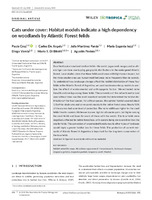Cats under cover : habitat models indicate a high dependency on woodlands by Atlantic Forest felids
Date
2019-03-01Author
Cruz, María Paula
De Angelo, Carlos Daniel
Martínez Pardo, Julia
Iezzi, María Eugenia
Varela, Diego Martin
Di Bitetti, Mario Santiago
Paviolo, Agustín Javier
Metadata
Show full item recordAbstract
Four Neotropical small and medium felids—the ocelot, jaguarundi, margay, and southern tiger cat—have overlapping geographic distributions in the endangered Atlantic Forest. Local studies show that these felids avoid areas with high human impact, but the three smaller ones use human‐modified areas more frequently than do ocelots. To understand how landscape changes affect the habitat distribution of these four felids in the Atlantic Forest of Argentina, we used maximum entropy models to analyze the effect of environmental and anthropogenic factors. We estimated niche breadth and overlap among these felids. The conversion of the native forest to land uses without trees was the most important variable that determined the habitat distribution of the four species. For all four species, the optimal habitat covered about 1/3 of the study area and corresponds mainly to the native forest areas. Nearly 50% of these areas had some level of protection. The niche width was higher for the small felids than for ocelots. Niche overlap was high for all species pairs, but higher among the small felids and lower for each of these with the ocelot. The four felids were negatively affected by native forest loss, with ocelots being more sensitive than the smaller felids. The conversion of unprotected forest areas to other types of land uses would imply a greater habitat loss for these felids. The protection of current remnants of Atlantic Forest in Argentina is important for the long‐term conservation of the four felids.
Collections
The following license files are associated with this item:




